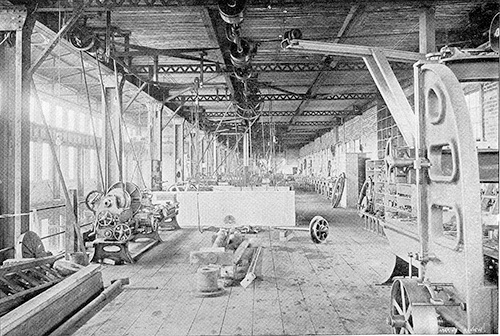 The second industrial revolution in the United States spanned just thirty-five years, from approximately 1865 to the end of the nineteenth century. In just a few decades, government and industry forces developed an interdependent system of people and machines that changed the ways in which most goods were produced.
The second industrial revolution in the United States spanned just thirty-five years, from approximately 1865 to the end of the nineteenth century. In just a few decades, government and industry forces developed an interdependent system of people and machines that changed the ways in which most goods were produced.
Besides factory systems that trained people to perform specific tasks very well and then repeat them throughout the day, for hours and hours on end, there were interchangeable parts and power-driven machines that made production even more efficient. Before interchangeable parts, one person would make a whole product, such as a rifle, from start to finish. That product would have design quirks and be slightly different from another similar product. For example, one individually produced rifle might have a trigger that was slightly different in shape and function from that of a rifle made by the same person. It might take a person weeks to make an entire finished rifle.
Use the information on the tabs below to learn about innovations that changed American industry.
Machine
Soup to Nuts
Steeling a Nation
 |
| A mechanized machine shop |
During the second industrial revolution, a much wider range of goods was produced, including steel, matches, canned food, and clothing. The rise of mass production hinged on the development of interchangeable parts and mechanized machine tools, which could produce individual parts of a whole product more efficiently than workers could. For example, boring machines and lathes helped to standardize rifle production. Interchangeable parts were combined with the factory system, large quantities of bulk-purchased raw materials, and powered machines. These developments resulted in cheaper, more quickly produced goods. Workers simply assembled machine-created parts into finished goods.
The most overlooked mass-produced item in the nineteenth century is canned food. This approach to feeding nation helped overcome a lack of refrigeration; canned foods are heated to kill bacteria and then vacuum sealed to prevent re-contamination. Most importantly, canned goods could be stored indefinitely. While American had always canned vegetables at home, the mass production of canned goods involved all kinds of foods, from milk to vegetables to meat to even soup. Some food—especially Borden's vacuum-packed milk—was mass canned before the Civil War. However, it was after the war that mass-produced canned food really became part of American culture, a development that began in earnest with the founding of the Campbell's Soup company in 1869.
 |
| The famous Campbell's logo |
Campbell's, which took its still-famous red and white color scheme from Cornell University, was started in Camden, New Jersey, by Joseph A. Campbell and Abraham Anderson. Its factories produced canned tomatoes, jellies, minced meat, and, of course, condensed soup. The soup was condensed for canning by removing the water, which could be added back in upon heating. Companies like Campbell's made food storage and preparation much easier, especially for Americans working long hours, but the innovations also led to a decrease in Americans' domestic skills. Within a generation, hunting, farming, and food preservation skills were lost to a significant part of the population.
 |
| Machines involved in Bessemer Process |
The most important development of the second industrial revolution was a method of producing steel known as the Bessemer Process. Lighter than iron, steel would be used in many products, such as springs, cans, rails, ships, and skyscrapers. Therefore, the efficient production of steel was a precursor to the manufacturing of a range of goods that changed American society.
The Bessemer Process, which produced steel from pig iron at a much lower cost, was developed by Henry Bessemer in 1856. It consists of blowing air through the molten pig iron, resulting in oxidation, which removes the iron's impurities, thereby creating steel. When the steel had been produced or converted from iron, it was poured into ladles. Alloys, or additional metals, could then be added to the steel. This process or conversion took about twenty minutes and transformed anywhere between 5 and 30 tons of iron into steel. The process was exploited to astounding effect by Andrew Carnegie, who in 1875 opened the Edgar Thompson Steel Works near Pittsburgh, Pennsylvania.
New and more efficient systems of production made life better for most Americans. Safely preserved food was more widely available, and steel made buildings larger and stronger, rail travel safer, and overseas travel more manageable. Use the activity below to review the innovations described on this page. Mach each innovation with its use.

